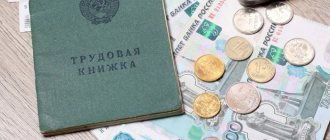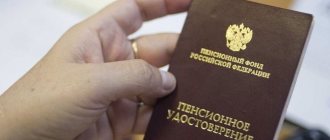Pension rights of citizens
The insurance (labor) pension ceases to be just a social subsidy “for old age”. The state's systematic policy related to pension provision allows every person to earn money for a dignified old age. After all, a modern pension consists of 3 components.
- A fixed payment is a certain amount paid by the state to each pensioner, regardless of his pension savings. The size of the fixed payment is set by the state and is annually indexed at least by the inflation rate for the previous year.
- Individual pension coefficient – pension point. The number of points is determined by the amount of contributions to the pension fund by the employer for the employee. The cost of a point is determined by the state and is subject to mandatory indexation at least according to the inflation rate for the year preceding indexation.
- The funded part of the pension, the volume of which depends on the amount accumulated during the citizen’s working life and the income from the investment of this amount. The funded part can be paid to the pensioner in a lump sum, urgently or for the rest of his life.
All these components are part of pension law. Each citizen will receive a “unique” pension, since 2/3 of its size is formed by payments to the Pension Fund and (or) NPF. Insurance contributions for a labor pension depend only on salary, or more precisely on its official part. And the higher the salary, the more pension points you can accumulate in the Pension Fund and the greater the amount accumulated in the funded part of the pension.
How wages in the Soviet years affect retirement
For each officially employed employee, the employer pays insurance contributions to the Pension Fund (PFR) from their salary. The transferred amounts are automatically converted into points and stored in the citizen’s personal account. It is beneficial for a person to have higher earnings, since the deductions will be higher.
As a result, more PB accumulates, so the amount of pension benefits will also be higher.
The point system began to operate in Russia only after the pension reform of 2015. Pensions for Soviet times and up to 2002 are now also converted into points, but a separate formula is used for this. For the period from 2002 to 2015, earned pension capital is used to calculate the PB.
When recalculating pensions for Soviet times, you need to know the amount of earnings. This will help determine what income is profitable to calculate:
- Refer to salary data for the period 2001–2002. The information is available in the Pension Fund and is used by default.
- Take a pensioner’s earnings for any 60 consecutive months. You will have to provide the information yourself if it is not included in the payment file.
Formula for calculating pensions until 2002
The number of PB earned by a citizen during the USSR and before 2002 can be determined by the formula:
Number of PB = amount of settlement capital / cost of 1 PB as of January 1, 2015 (64.10 rubles).
- Russians are expecting another increase in the retirement age
- How to disable the Who called service on Megafon
- Vegetable casserole in the oven - step-by-step recipes for cooking with cottage cheese, cheese or meat
To determine the amount of estimated capital, you need to make certain calculations:
- Find out the experience coefficient (SC). It is 0.55 for men who have worked for 25 years and women with 20 years of experience. For each additional year of work, 0.01 is added. The ceiling is set at 0.75.
- Determine the coefficient of average monthly earnings (ASM). For this, we need data on wages, which will show how profitable the calculation is. When calculating, the average monthly income is divided by the average salary in the country for the same period of time.
- Calculate the amount of the estimated pension (RP). The size of the experience coefficient is taken into account:
If does not exceed 0.55:
RP = SK x KSZ x 1,671 – 450, where:
- 1 671 – average salary in the country in December 2001;
- 450 – the basic amount of pension payment established by law No. 173-FZ (12/17/2001).
The value (SC x KSZ x 1,671) cannot be lower than 660. If during calculations the resulting amount is lower, the RP value is set at 210 rubles.
If above 0.55:
RP = (SK x KSZ x 1,671 – 450) x Experience, where:
- Experience for women = number of years worked before 2002 divided by 20;
- Service experience for men = number of years worked before 2002 divided by 25.
If the calculations (SC x KSZ x 1,671) result in less than 660, the RP value is set at 210 rubles.
- Carry out valorization. This is a one-time increase in the received RP amount by 10%. The valorization of Soviet-era pensions provides an additional bonus for those employees who have work experience before 1991. For each full year, 1% is added to the existing 10%.
- Use a correction factor. The valorized RP amount is multiplied by 5.6148. This is the product of annual inflation indices between 2002 and 2014.
Limiting factor
Speaking about the average earnings coefficient, which determines whether it is profitable to take into account income in Soviet times, it is important not to forget about one subtlety. The legislation establishes that it cannot exceed the value of 1.2. The exception is residents of the Far North and similar areas. For them, the permissible value varies from 1.4 to 1.9 depending on the area of residence.
What is more important – experience or salary?
Ideally, a citizen should receive a high salary throughout his entire working life. But this does not happen to everyone, and many are interested in whether it is possible to earn a decent pension by receiving the “minimum wage”. If you do not consider the funded part of the pension and pay attention only to the insurance part, then you can trace a rather interesting trend here.
Let's consider abstract citizen "A", who served in the army and worked in Moscow for a very modest 20,000 rubles. per month. Let's assume that his work experience is 40 years. Therefore, he will receive 12,773 rubles. This amount is formed:
- RUB 5,334 – fixed payment;
- RUR 7,439 – individual pension coefficient.
IPK (pension points), in turn, are formed, among other things, by military service in the Armed Forces of the Russian Federation, for which an additional 1.8 points are awarded. In monetary terms, this is only 157 rubles. The remaining 7,282 rubles. formed exclusively by insurance contributions to the Pension Fund.
Another abstract citizen “B” worked for only 20 years, did not serve in the army, but received a salary of 50,000 rubles. His pension from contributions will be 14,437 rubles, that is, by 1,664 rubles. more.
But why? After all, the length of service of citizen “B” is half as long as that of “A”, so it seems that he will receive less... But the answer “lies on the surface”: contributions to the Pension Fund for citizen “B” turned out to be higher simply because his salary was higher . His pension also consists of 2 amounts, but if “A” earned only 85.28, then “B” received 104.35.
This means that 1 year of work excluding military service of citizen “A” earned 2,087 points. But “B” received 5.2175 points for his year, that is, 2.5 times more. But is it possible to earn a million-dollar pension?
How many points can you earn?
Since the amount of pension benefits depends entirely on salary, people have a reasonable question: what salary should be for calculating a pension in order to receive as much as possible?
The law provides for a restriction on the accrual of pension points. Starting from 2015, the maximum salary taken into account when calculating points has been systematically increased. In 2019, it is expected that the maximum base for contributions to the Pension Fund will be set at 1,150,00 rubles. For equal (or higher) contributions, 9.13 points will be awarded (since funded pensions are frozen). Well, starting from 2021, a citizen will be able to claim 10 points per year, regardless of the size of their salary and the amount of deductions.
Therefore, if we consider the option of receiving the maximum salary throughout the entire working life, and the length of service began on January 1, 2015, then over 40 years of work the citizen will earn 390.88 points. In monetary terms at 2021 prices, a citizen’s pension will be 34,100.37 rubles. for points and 5,334.19 fixed payment. Total – 39,434.56 rubles.
Requirements for experience and IPK
Salary for calculating a pension is not just important, but “vital” if a citizen is going to retire upon reaching retirement age - 65 or 60 years (men/women). It's all about the requirements set by the state not only for length of service, but also for the amount of accumulated points.
From 2025, the IPC amount must be at least 30 points with 15 years of experience. But such a high point score cannot be achieved if you work these 15 years for the “minimum wage”. To earn the minimum old-age insurance pension when working for the minimum wage, a citizen will need 26 years.
A Muscovite, 36-year-old Alexander F, contacted a lawyer. The man asked for the lawyer’s help in calculating his pension rights, provided that Alexander received a “gray” salary. The employer makes all deductions based on the minimum wage, and the citizen’s account has accumulated only 11 points over 14.5 years of work. The lawyer explained that if Alexander does not take action to increase the volume of deductions, his account will accumulate only 45.13 points by the end of his working career at 65 years old, and the size of the pension in 2021 prices will be 9,271.33 rubles, that is, slightly higher living wage for a pensioner.
Due to frequent updates to legislation and the legal uniqueness of each situation, we recommend obtaining a free telephone consultation with a lawyer. You can ask your question by calling the hotline number 8 (800) 555-40-36 or write it in the form below.
Which earnings to choose for calculating your pension?
It is approximately possible to calculate whether the Soviet salary will be beneficial for calculating pension benefits. First, you need to visit the territorial office of the Pension Fund of the Russian Federation and find out the value of the coefficient. If for the period from 2001 to 2002 it already has a maximum value, there is no point in turning to Soviet earnings for a pensioner.
- 6 reasons why your eyelids hurt a lot
- 6 best health tours for retirees
- Microcurrent therapy - beneficial properties for the face and body, indications for the procedure and side effects
Provided that the value is not entirely profitable, since it does not reach the limiting value, it is important to present a certificate of salary for the Soviet era.
Based on data on average wages in the USSR, it is possible to determine what minimum one needed to receive at that time and choose the optimal, more profitable 60-month period in terms of earnings. To do this, you need to multiply the amount of earnings by 1.2 (northerners use the corresponding indicator established for them):
- 1980 - 209 rubles;
- 1981 – 214 rubles;
- 1982 – 221 rubles;
- 1983 – 226 rubles;
- 1984 – 232 rubles;
- 1985 – 240 rubles;
- 1986 – 248 rubles;
- 1987 – 258 rubles;
- 1988 – 280 rubles;
- 1989 – 315 rubles;
- 1990 – 364 rub.
If the limit coefficient does not reach the maximum
The Constitutional Court of the Russian Federation ruled that the rights of citizens who earned a pension during Soviet times cannot deteriorate regardless of changes in legislation. For this reason, a person has the right to demand a recalculation of pension benefits for work during the Soviet era.
The Soviet salary must be officially confirmed to calculate the pension. It is better to prepare in advance and provide information to the Pension Fund before the appointment of the insurance pension, so as not to have to recalculate it later.
To obtain a certificate of earnings, a citizen needs to contact the enterprise where he previously worked.
If the organization is liquidated, the application is written to the archives. You can find out the exact address and departmental affiliation of the archival organization directly from the Pension Fund of Russia. You can also obtain a certificate by contacting the Multifunctional Center (MFC) or filling out a special application on the Rosarkhiv website. Services are provided free of charge.









